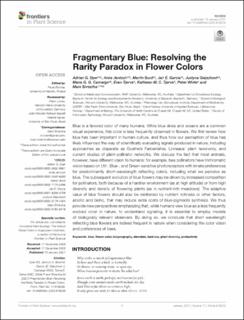| dc.description.abstract | Blue is a favored color of many humans. While blue skies and oceans are a common visual experience, this color is less frequently observed in flowers. We first review how blue has been important in human culture, and thus how our perception of blue has likely influenced the way of scientifically evaluating signals produced in nature, including approaches as disparate as Goethe’s Farbenlehre, Linneaus’ plant taxonomy, and current studies of plant-pollinator networks. We discuss the fact that most animals, however, have different vision to humans; for example, bee pollinators have trichromatic vision based on UV-, Blue-, and Green-sensitive photoreceptors with innate preferences for predominantly short-wavelength reflecting colors, including what we perceive as blue. The subsequent evolution of blue flowers may be driven by increased competition for pollinators, both because of a harsher environment (as at high altitude) or from high diversity and density of flowering plants (as in nutrient-rich meadows). The adaptive value of blue flowers should also be reinforced by nutrient richness or other factors, abiotic and biotic, that may reduce extra costs of blue-pigments synthesis. We thus provide new perspectives emphasizing that, while humans view blue as a less frequently evolved color in nature, to understand signaling, it is essential to employ models of biologically relevant observers. By doing so, we conclude that short wavelength reflecting blue flowers are indeed frequent in nature when considering the color vision and preferences of bees. | en_US |

